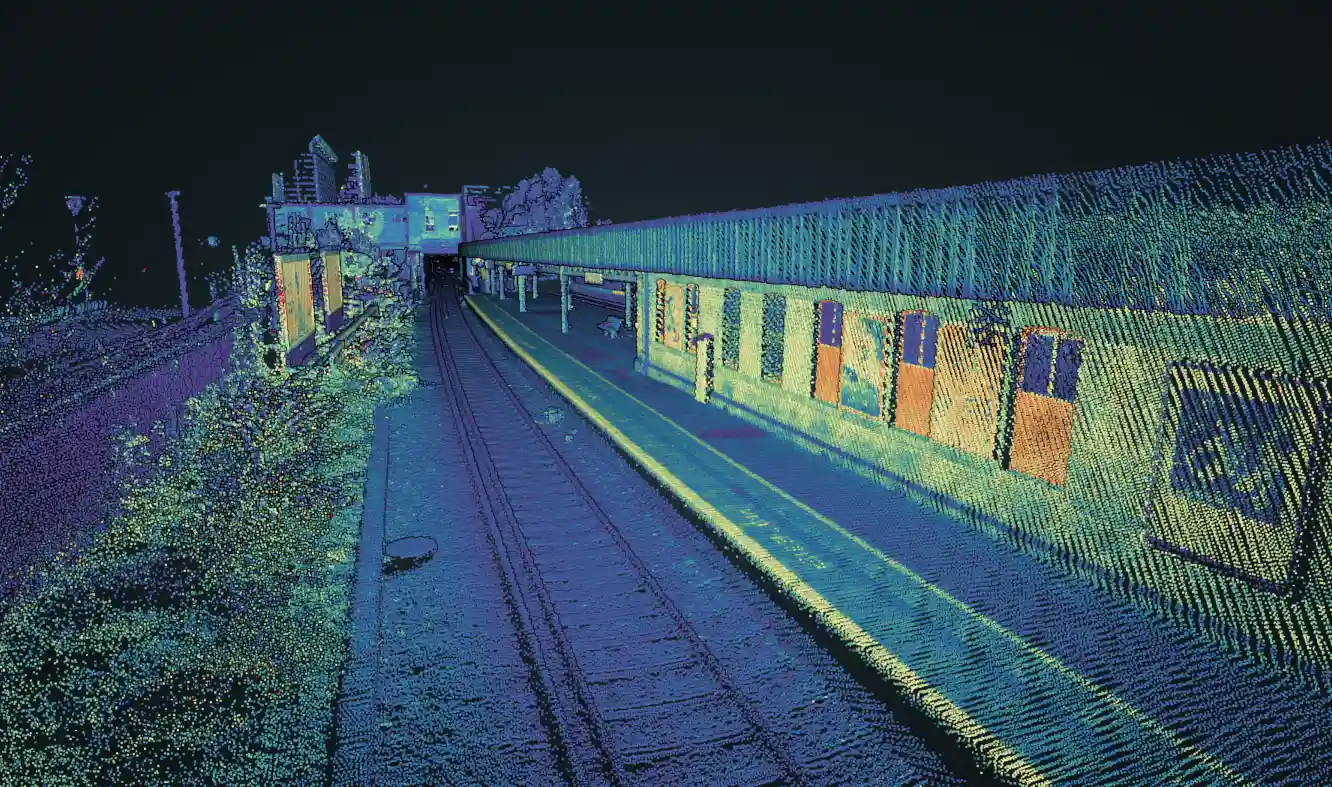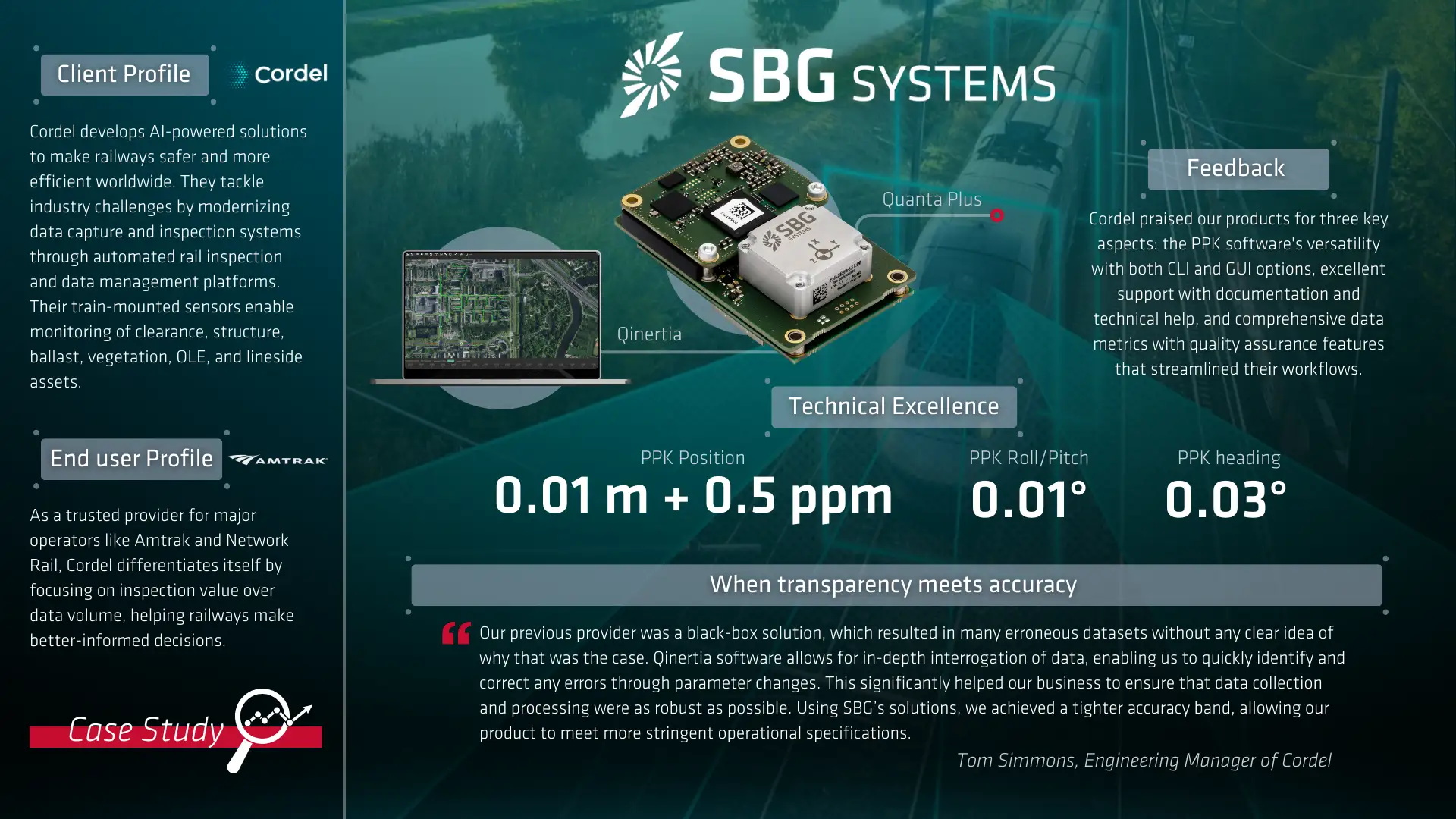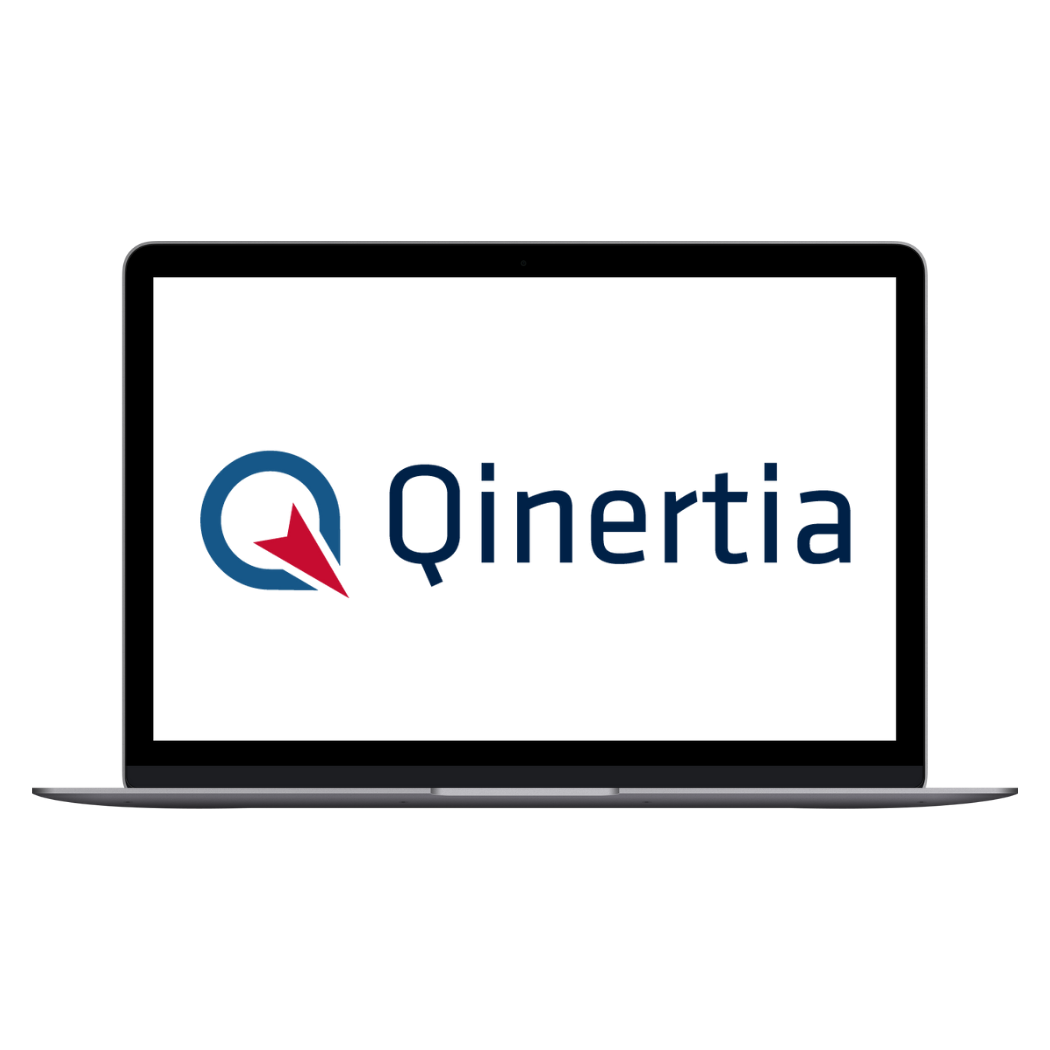On the right track: Cordel’s railway maintenance with Quanta Plus and Qinertia
Cordel praised our solutions for railway maintenance in three key aspects: the PPK software’s versatility with both CLI and GUI options, excellent support with documentation and technical help, and comprehensive data metrics with quality assurance features that streamlined their workflows.
Qinertia software allows for in-depth interrogation of data, enabling us to quickly identify and correct any errors through parameter changes. This significantly helped our business to ensure that data collection and processing were as robust as possible. | Tom Simmons, Engineering Manager of Cordel.
Here’s a unique case study exploring an innovative application by Cordel for railway maintenance. Let’s start by getting to know Cordel and what they do.
Cordel is dedicated to making railways safer, more efficient and sustainable worldwide. Their mission focuses on solving long-standing challenges in the rail industry, such as outdated data capture methods and expensive inspection systems. Powered by AI, Cordel’s next-generation solutions offer a faster, more automated way to collect and process rail inspection data. They also provide a reliable, rail-focused data management platform, making inspections much more efficient.
Cordel’s solutions use advanced train-mounted sensors that support specialised monitoring tasks like clearance analysis, structure gauging, ballast profiling, vegetation management, overhead line equipment (OLE) assessments, and lineside asset monitoring. Trusted by leading rail operators such as Amtrak, Network Rail and ARTC, Cordel has established itself as an innovator in railway technology. What truly sets Cordel apart is their focus on the value of inspections rather than just the volume of data collected. This approach not only enhances operational efficiency but also enables the rail industry to make smarter, more informed decisions.
Cordel’s technical requirements
Cordel needed an advanced Inertial Navigation System (INS) that could seamlessly integrate with their train-borne LiDAR technology. Their main challenge was achieving highly accurate positioning in environments that typically challenge INS systems, such as tunnels, urban canyons and rail cuttings. The system had to reliably fuse LiDAR data onto a 3D map, ensuring accurate asset mapping even in difficult GNSS conditions. Additionally, post-processing of bulk data needed to be automated, with strong quality assurance capabilities.
Cordel’s criteria also included a user-friendly and efficient post-processing software for automatically processing large volumes of diverse train-borne INS data. They needed a robust PPK platform with automation capabilities that also provided quality assurance artefacts to maintain reliable data quality.
Cordel’s flagship products: Wave sensors
Cordel’s wave sensors combine a LiDAR scanner, RGB video system, and INS to enable unattended data capture from a train-borne system. The wave lineup includes two main products: the Wave Rugged and the Wave OEM.

- The Wave Rugged is designed as a standalone system that can be easily integrated onto various types of rolling stock, including targeted inspection vehicles like hy-rail/road-rail vehicles and MPVs.
- The Wave OEM system, in contrast, allows for tight integration into passenger trains or locomotives, breaking the components down for efficient deployment.
After evaluating Cordel’s requirements, we recommended Quanta Plus, paired with our post-processing software, Qinertia for their railway maintenance work.
Our solutions for railway maintenance: Quanta Plus and Qinertia
Quanta Plus offers:
- High precision: Centimetre-level positioning, essential for Cordel’s LiDAR data capture.
- Strong performance in challenging environments: Quanta Plus excels in difficult conditions like tunnels and urban canyons, where other systems often struggle.
- Rail compliance: Seamless integration into rail-compliant systems, making it an ideal choice for Cordel’s Wave Rugged and Wave OEM products.
Qinertia, the advanced Post-Processed Kinematic (PPK) software, provided Cordel with the automation capabilities they required. Its Command Line Interface (CLI) enabled the bulk processing of data while maintaining strong quality assurance through in-depth data interrogation and error diagnosis.
From initial hiccup to tailored solution
Initially, Cordel did not adopt our products for their first revision of the train-borne capture system due to the need for more automation in the Qinertia software. However, within a year, we addressed these needs by enhancing Qinertia to meet Cordel’s specific requirements. This marked the transition to our solutions, which became integral to Cordel’s inspection system.
One of the key benefits Cordel highlighted is the exceptional user experience across the entire product lifecycle—from development all the way to system use. They found the integration process smooth, thanks to the comprehensive documentation that made setup straightforward. The device interface is intuitive, making it easy to develop communication drivers. On the software side, they appreciated how our post-processing tools provided an efficient and hassle-free experience. Plus, the hardware proved to be highly reliable and rugged, standing up to tough environmental conditions while delivering consistent performance.
Adding to this, Tom Simmons shared: “Once we moved to the SBG product stack, the biggest change was the ability to diagnose and address any issues with the PPK process. Our previous provider was a black-box solution, which resulted in many erroneous datasets without any clear idea of why that was the case. Qinertia software allows for in-depth interrogation of data, enabling us to quickly identify and correct any errors through parameter changes. This significantly helped our business to ensure that data collection and processing were as robust as possible. Using SBG’s solutions, we achieved a tighter accuracy band, allowing our product to meet more stringent operational specifications.“
Strong Partnership and Support
Throughout the engagement, Cordel was impressed with our support team. From the start, Cordel found our team responsive and knowledgeable. Despite being self-sufficient, Cordel appreciated the strong documentation and support portal, which helped them confidently resolve complex technical questions in their pursuit of railway maintenance excellence.
Tom Simmons added, “We were well supported during the integration of Quanta Plus into our system. The standard documentation was more than enough to complete most of the design. We were also supported well by a very responsive support team, who were able to inform any complex questions or provide general advice. The support portal was also immensely helpful in the integration of the system within our product. It had all the necessary documentation to design against and had good coverage on all the information that we required.”

Cordel’s top three picks
Cordel emphasised three standout aspects they love about working with SBG Systems.
- PPK software and automation: First, they appreciated the flexibility and power of our PPK software and automation. Having both a command-line interface (CLI) for full automation and a user-friendly graphical interface (GUI) means they can easily streamline their data processing while still having the option to dive deeper if any issues arise.
- Support: Cordel valued the support they received throughout their engagement. From thorough documentation to prompt technical assistance, they felt confident that any challenges would be addressed quickly and effectively, ensuring a smooth experience.
- Data metrics: Finally, they highlighted the comprehensive data metrics provided by both the hardware system and PPK software. These reliable data points are key for validating output accuracy, helping them ensure their operations are precise and dependable. Our strong quality assurance processes have really built their confidence in automating data collection and processing.
This journey has been a fantastic learning experience, and seeing our customers satisfied is what it’s all about. Michael Jeffrey, who played a key role in sales and after-sales at SBG Systems, had some great words to share about Cordel: “Working with Cordel is always a pleasure. Their honesty and transparency give us valuable insight into their needs, allowing us to tailor our solutions to address their unique challenges effectively. They have a clear vision and are true innovators in rail inspection technology, and we are incredibly proud to partner with them.“

Qinertia GNSS+INS PPK software
Qinertia PPK software offers an all-new level in high-precision positioning solutions.
Achieve unparalleled accuracy in your workflows by post-processing your raw location data.

Ask a quotation for Qinertia
Do you have questions?
Welcome to our FAQ section! Here, you’ll find answers to the most common questions about the applications we showcase. If you don’t find what you’re looking for, feel free to contact us directly!
What is the difference between RTK and PPK?
Real-Time Kinematic (RTK) is a positioning technique where GNSS corrections are transmitted in near real time, typically using an RTCM format correction stream. However, there can be challenges in ensuring the GNSS corrections, specifically their completeness, availability, coverage, and compatibility.
The major advantage of PPK over RTK post processing is that the data processing activities can be optimized during post-processing, including forward and backward processing, whereas in real-time processing, any interruption or incompatibility in the corrections and their transmission will lead to lower accuracy positioning.
A first key advantage of GNSS post-processing (PPK) vs. real time (RTK) is that the system used on the field does not need to have a datalink/radio to feed the RTCM corrections coming from the CORS into the INS/GNSS system.
The main limitation to post processing adoption is the requirement of the final application to act on the environment. On the other hand, if your application can withstand the additional processing time needed to produce an optimized trajectory, it will greatly improve the data quality for all your deliverables.
How does forward and backward processing works?
Let’s imagine we have a 60-second GNSS outage in the middle of our survey. The position error in forward processing grows fast (rate depends on the IMU specifications and other parameters) and reaches its maximum at the end of the outage. It then quickly recovers. In post processing, we pretend that time flows backward and do the processing in anti-chronological order as the physical equations remains valid. In this backward processing, the error would be maximum at the actual beginning of the GNSS outage in a very symmetrical way to the natural forward processing.
Merging those two computation results in a maximum error around the middle of the outage, with a much lower magnitude than the forward only or backward only solutions.This will especially improve GNSS+INS solutions as allowed by SBG Systems products, but GNSS only processing will also benefit from this workflow.
As already stated, this improvement can only be done via post-processing, as you need all the data to be available from start to the end, hence delaying its use to the end of the survey.
What is GNSS post-processing?
GNSS post-processing, or PPK, is an approach where the raw GNSS data measurements logged on a GNSS receiver are processed after the data acquisition activity. They can be combined with other sources of GNSS measurements to provide the most complete and accurate kinematic trajectory for that GNSS receiver, even in the most challenging environments.
These other sources can be local GNSS base station at or near the data acquisition project, or existing continuously operating reference stations (CORS) typically offered by governmental agencies and/or commercial CORS network providers.
A Post-Processing Kinematic (PPK) software can make use of freely available GNSS satellite orbit and clock information, to help further improve the accuracy. PPK allow for precise determination of a local GNSS base station’s location in an absolute global coordinate reference frame datum, which is used.
PPK software can also support complex transformations between different coordinate reference frames in support of engineering projects.
In other words, it gives access to corrections, enhances the project’s accuracy, and can even repair data losses or errors during the survey or installation after the mission.
